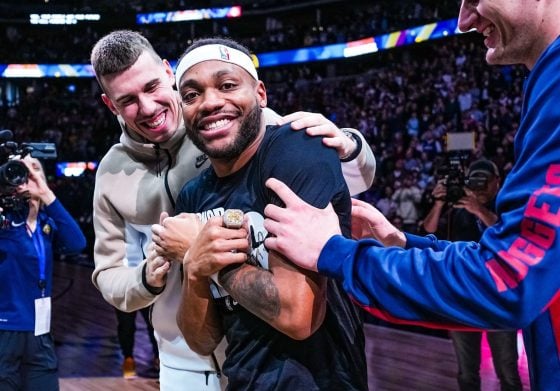Three-point shooting is one of the most data-driven aspects of NBA basketball. Whole rosters have been built around the idea that three is objectively a larger number than two, leading once to the 2021 NBA championship for the Milwaukee Bucks and 27 straight missed threes by the Houston Rockets in Game 7 of the 2018 Western Conference Finals.
In my overcomplicated worldview, watching Al Horford—or any NBA player really—shoot threes is much less data than it is watching an action movie, particularly the one I thought was the coolest thing ever when I was eight: Fast Five. Hear me out on this one, I promise it’s going to be fun.
Fast Five is the quintessential overdo-literally-everything action movie. The individual action sequences are so sick that you ignore that how we got here makes zero sense. Now consider the overnight makeover of Horford. For the first eight years of his career, he shot a combined 21-of-65 from three-point land… then WHAM, he quadrupled his total career attempts in his ninth season alone.
There’s your big opening action sequence after some boring exposition. Cut to Paul Walker and Jordana Brewster flipping over the prison bus and breaking Vin Diesel—also known as Al Horford’s three-point skills—out of the slammer.
Two seasons later was the first big train heist scene, where Horford shot a bananas 42.9 percent from beyond the arc, which is better than any season of Klay Thompson’s career. If that stat sounds like sample size manipulation, that’s because it is.
But Horford was still cool before he shot threes, just like the Fast and Furious franchise was still awesome before they added The Rock to the cast. Horford made an All-NBA team in 2011, a season in which he shot four total three-balls. But adding range to his game was like adding an A++ list actor to the bunch.
Three-pointers brought Horford to the next stage of his career, and he adapted alongside the NBA’s desire for stretch bigs. And Big Al hovered around 200ish attempts per year for a while, shooting a respectable 35 percent in the four years following the 43 percent explosion.
That’s where the movie kind of slogs on. It’s the meat of the two hours, needed to get the thing off the production set and into the theaters. We’re getting the team together, requisitioning fast cars, planning a big bank heist… yada yada yada.
But you know it’s building towards some sort of final scene. And the 2022-2023 regular season was as awesome as dragging a bank vault behind two tricked-out Dodge Chargers through downtown Rio de Janeiro, pulling off an Oceans 11 twist and ultimately stealing $100 million from a drug dealer. Horford shot a comically amazing 45 percent from downtown on a career-high in attempts. Movie over, metaphor over, Al is an elite shooter, everything is awesome.
And just like I just landed the plane on this absurd premise, it felt like he landed the plane on his career arc. At the ripe young age of 36, Horford evolved from a stretch-big to a legitimate threat from beyond the arc. He went from a player you couldn’t blindly help off of to someone you had to actually account for from 24 feet away.
No data scientist will ever empirically prove that a shooter “getting hot” is a real thing, since the sample sizes are way too small to quantify much of anything. But if you’ve ever played pickup basketball, you know the continent-sized jump that Horford made from the 2021-2022 regular season to the playoffs was just that.
In that season, Horford shot 34 percent before ratcheting it up 14 percent to a nuclear 48 percent in the playoffs en route to the Celtics’ first Finals appearance since 2010. He conceivably rode that streak all the way through the following regular season, to awesome results. Every shot that went in felt like another gasoline-fueled action sequence, too good to be true in the realm of mere mortals like me.
But therein lies the problem with Fast Five: it ends. No matter how cool the cars were, how sick that one drag race was, or how staggering it was when Vin Diesel and Paul Walker jumped off a 500-foot cliff into a lake and walked it off, eventually, reality sets in.
Horford cratered to 29 percent from downtown in a playoff run that—despite coming within one game of the NBA Finals—felt more like open-heart surgery than anything else. He ran into the law of averages like a truck hitting the side of a moving train, and his legendary splits from the previous season and change came back down to Earth in the worst way.
Even though eight-year-old me got to see Fast Five in theaters over the weekend, I still had to go to math class on Monday. I don’t accept the cliché “live by the three, die by the three” as an actual basketball worldview, but balancing Horford’s three-point attempts in the face of mathematical reality seems like a necessary step.
Or what if the Celtics just… didn’t do that? What if they accepted my insane theory that three-point shooting isn’t actually about math but rather a borderline-psychotic fan experience that’s closer to a Hollywood adrenaline cocktail than something you can control?
If I were in charge—and there are reasons I am not—I would tell Big Al to let it rip. Because winning an NBA title isn’t logical — it’s an action movie, trying to string together two hours of glory for the rest of our lives.






